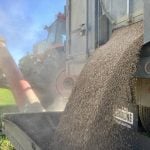Up to 80 per cent of pesticide contamination on a farm occurs where a sprayer is washed, filled, handled or rinsed — but there’s a simple and inexpensive way to prevent it.
Biobeds, already in use in the U.K., Scandinavia, and South America, are trenches filled with absorbent materials (such as peat moss, compost or biochar), soil, and straw or wood chips.
“It’s a fairly simple system that basically absorbs pesticides,” said Larry Braul, a water quality engineer with Agriculture and Agri-Food Canada in Regina. “By introducing micro-organisms that break it down, the pesticide is degraded over time.”
Braul and Ag Canada colleague Claudia Sheedy in Lethbridge are leading a project to Canadianize the European innovation.
“What we’re trying to do is take the idea that they’ve adopted in Europe and adapt it to the Canadian climate,” said Braul.
“There are a few challenges with that. One of them is that it’s a lot colder here. It’s a bit more challenging.”
Micro-organisms can’t do their job when it’s too cold, and so the researchers are looking at heating methods, including solar, to keep them warm and active.

“The big goal associated with the project is to solve any issue with biobeds and make them practical,” said Braul. “We’re actually trying to understand the microbial population within the biobed.”
The research is looking at the ideal mix of material in the beds and the effect of torrential heavy rainstorms that are common on the Prairies.
The goal is to adapt European designs and create a construction, operation and maintenance manual for biobeds that will function well in the Prairie climate. So far, an above-ground biobed and a pit with a geothermal membrane are the leading candidates.
The price tag for a biobed will likely range between $4,000 and $8,000 depending on the size of sprayer, accessibility to electricity, and materials used, said Braul. If the collection pad is concrete, that would add another $5,000 to the cost.
Read Also

Hail research hopes to benefit potato growers
Alberta research scientist measures hail storm and heat dome affects on potato crops
Researchers are also working with farmers to test prototypes and establish practical guidelines for using them.
“When you introduce something like this, a producer always has some comments on how we can change it to make it better and more practical,” said Braul.
Test biobeds have already been installed in the County of Grande Prairie and Outlook, Sask. Another test facility will open near Vegreville in spring.
The concept was first introduced to Canada in 2008 after former Ag Canada researcher Tom Wolfe encountered biobeds on a trip to Sweden.
















